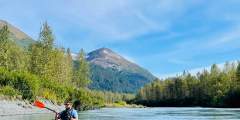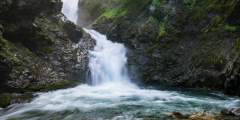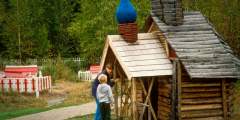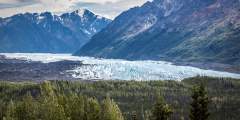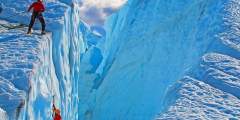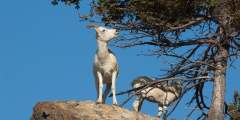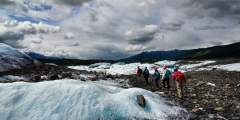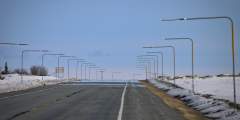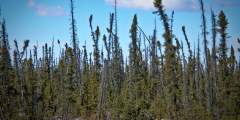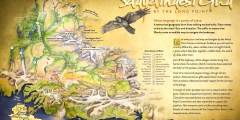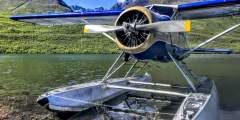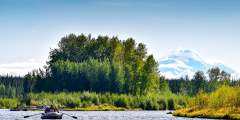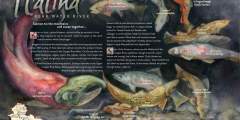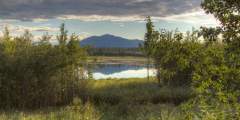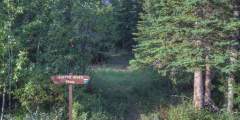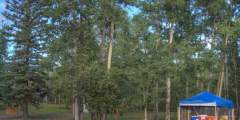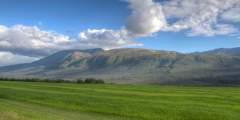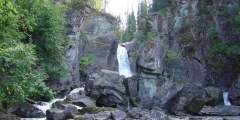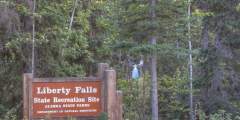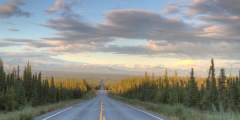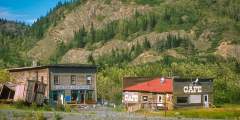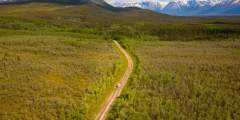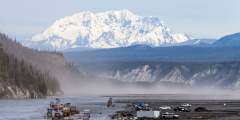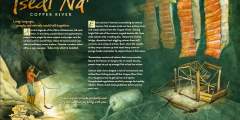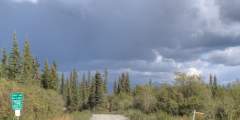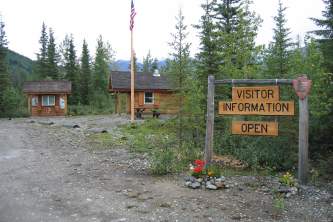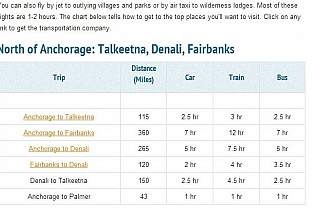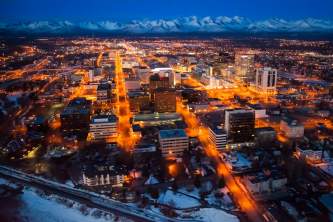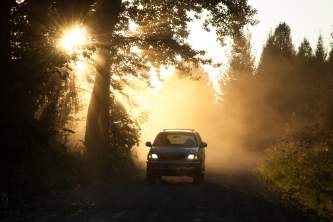Anchorage to McCarthy-Kennicott
The drive to McCarthy and Kennicott isn't your run-of-the-mill road trip. It's 7-8 hours from Anchorage, with the last 61 miles-between Chitina and the Kennicott River-on an historic, gravel road. Not all rental vehicles are allowed on the McCarthy road, so check with your rental agency before you travel. Or, rent from Alaska 4x4 Rentals or Alaska Overlander, they allow their vehicles on the McCarthy Road.
At the end of the McCarthy Road, a footbridge brings you across the river to McCarthy and Kennicott. Once a rowdy pioneer town, McCarthy now makes a great basecamp for adventures into American's largest national park, Wrangell-St.Elias.
Four mountain ranges converge in this remote park the size of six Yellowstones. Kennicott was abandoned during the Depression, and visitors can explore the past on a tour of this historic ghost town. Leave early enough from Anchorage and you can enjoy some of the scenic highlights and activities on your way there.
Short on time? With Copper Valley Air Service can drive to Glennallen and fly to McCarthy. Or, fly direct from Anchorage.
Show Map
Driving Guide
Anchorage to Glennallen
Embark on an unforgettable paddling adventure in Alaska with AK Paddlesports! Nestled just outside Anchorage, this family-founded company offers a vast selection of top-quality watercraft, including paddleboards, kayaks, and canoes, available for rent by the day. Experience the convenience of equipment delivery and pick-up, allowing you to spend more time exploring Alaska’s scenic lakes.
Who can say no to a cool waterfall only a half-hour’s drive from town? One of the most popular “first hikes” for families with small children, the one-mile trail to Thunderbird Falls traverses a handsome birch forest along the Eklutna River canyon to reach a deck with views of a 200-foot waterfall. During winter, the falls can freeze, forming fabulous columns of blue ice.
Dating back to 1650, the park is the area’s oldest continuously inhabited Athabaskan settlement. View the colorful Spirit Houses built over the graves of the deceased, along with an Orthodox Christian Cross — a custom that came from the melding of the cultures.
The campground is pretty open, since bark beetles killed the big, old spruce trees. The campsites attract RVers and campers, and each of the 24 sites has a fire ring and picnic table. There’s potable water at a hand pump.
Looking to break up your drive with a jog or bike ride? This little-used, 2‑mile section of the former Glenn Highway has little to no traffic. Rocks and shrubs are creeping onto the road surface in places. It’s quiet, scenic, and hilly. The roadway is officially closed in the middle but easily-passable.
The Matanuska State Park is the best place for a free view of the Matanuska Glacier. You won’t be able to walk up to the glacier (that’s at Mile 102), but this well-developed site offers plenty of parking, overnight camping, public restrooms, and excellent glacier views and photo opportunities. You’ll also find: A half-dozen interpretive signs about glaciers, ice creatures, spruce bark beetles. Great viewpoints with telescopes. A… ...more
It’s only a small pull-out on the side of the highway, but this is the closest viewpoint of the Matanuska Glacier. If you don’t have a powerful zoom on your camera, or just want to get a great look at the ice, this is the spot. There’s only room for about six cars and the feel is a bit more rustic than the official state rec site a mile to the west, but you’ll be perched on a bluff overlooking the glacier. Distance 103.3 miles north of… ...more
There’s climbing a mountain – and then there’s climbing an ICE mountain. Regardless of your climbing ability or experience, you’ll end the day feeling fulfilled and inspired. MICA also offers short, guided hikes and longer treks if you prefer a more leisurely explore of the glacier and its grandeur.
Lion’s Head is famous throughout the state. This rock outcropping is the prominent feature beside the Matanuska Glacier and is featured in magazines and advertisements all over Alaska. And you can hike it! You’ve got to be in good shape and ready for a scrambling, one-hour climb. You’ll be rewarded by great views, looking down a 2,000-foot cliff face to the glacier. You’re panorama will include views of the Matanuska River, Caribou Creek with… ...more
South-facing slopes can concentrate large numbers of sheep that are especially visible after green-up in the spring. Lodges in the area provide spotting scopes and good advice, and there are several pullouts and trailheads with safe parking.
People love to pull off here and shoot a photo beside this classic sign. A local theory on the creek name is that the crusty, old sourdough who lived down near the creek used mules for guiding hunts. These mules purportedly escaped a lot, so the asses were always by the creek. Who knows? But it’s a classic photo for the friends back home.
Just south of the Caribou Creek bridge near mile marker 104 on the Glenn Highway in the shadow of the Lion’s Head rock formation, look for the turnoff for the Caribou Creek Recreational Mining Area. You are not going to get fabulously rich here and be the next star of the TV reality show Gold Rush, but you do have the opportunity to carry a gold pan and shovel, hike the steep half-mile-long trail down to the creek, and pan for gold.
Some 15,000 years ago, this glacier reached another 50 miles west to the Palmer area. It now has a four-mile wide towering face that you can walk right up to and touch. Keep an eye out for summertime ice-climbers at this most impressive roadside glacier. Directions: Head north from Anchorage on the Glenn Highway. At mile 102, you can drive down to Glacier Park (888−253−4480), then hike 15 – 20 minutes to the face of glacier.Distance: 102 miles ...more
Climb to the summit of Belanger Pass, bike an all-day loop to Caribou Creek or off-road in a four-wheeler or ATV. This public access area is a gateway to adventure in the rolling tundra and alpine ridges of Belanger Pass and Syncline Mountain. The hike to the top of Belanger Pass is 90 minutes, following an old, rutted road. You can also bike this, following the Mining Road Trail for an all-day, 35 mile ride to Syncline Mountain and Caribou… ...more
This is one of Alaska’s premier recreation meccas. You’ll see lots of big-boy toys around Eureka Summit: RVs or big trucks pulling trailers with ATVs or brand new snow machines. This summit receives several feet of snow each winter, and rugged trails open access to the terrain during summer. Eureka Summit is the highest point along the Glenn Highway.
Even though black spruce forests look sickly, they’re actually healthy trees. Their shallow roots spread over permafrost, so they grow slowly. Soil above the permafrost melts and freezes, buckling the ground and making the trees tip. This stand might’ve sprouted around the same time as World War I, or even earlier. Maybe back when there were only ten miles of paved roads in the entire country.
Glennallen to McCarthy
The town of Glenallen is named after two early explorers. Henry Allen was a lieutenant who travelled through this area in 1885 on his way to the Yukon River, and Capt. Edwin Glenn was part of the U.S. Government survey crew for the Richardson Highway that came through in 1898 – 99. Glennallen is also a part of the Copper River Watershed. Find the interpretive sign at the visitor’s center and orient yourself in the watershed with a map of Ahtna ...more
Year-round air service from Glennallen, Alaska. Short on time? Check Alaska’s largest national park off your list with a flightseeing tour that includes a landing in the wilderness of the park. Traveling to McCarthy / Kennicott? Travel like the locals and hop on a mail plane flight. See how backcountry mail is delivered and enjoy speedy transportation to McCarthy. Or, opt for their scheduled air service. Both have departures from Anchorage and ...more
Just outside Glennallen you’ll find some great views of the Copper River and the Wrangell Mountains, as well as the chance to take some photos that don’t include any roads or buildings. Mt. Drum will be straight in front of you, with Mt. Sanford on the left side, and Mt. Wrangell— a massive shield volcano — on the right. Cloud cover is the only way you’ll miss this dramatic scene. And these mountains are definitely dramatic. The western… ...more
Exploring the rivers of Copper Center, around 4 hours from Anchorage and right on the edge of gorgeous Wrangell-St. Elias National Park, brings opportunities for everything from mild floats to Class III and IV rapids. Since the Copper River Basin is a little more remote than other areas, you’ll be able to truly appreciate the wilderness as you enjoy a relaxing day on the water.
Historic Copper Center is one of the oldest non-native communities in Alaska’s Interior. Founded as a government agricultural experimental station, it later served as a transportation center for gold rush prospectors. Also find the interpretive sign where you’ll learn about the local fish species that make their home in different habitat niches of Copper River watershed creeks and rivers.
Get a taste of early 19th-century Alaska in Copper Center. This small community located at the confluence of the Klutina and Copper Rivers, was established in 1898 as a camp for prospecting gold miners. After the Richardson Highway route opened in 1900, roadhouses sprung up every 15 to 20 miles, providing services for travelers between Valdez and Fairbanks. You could get meals, lodging, mail service, medical help, hay for your horse, gasoline… ...more
Route 4 from Valdez to Delta Junction, Route 2 from Delta Junction to Fairbanks. Speed Limit: 50 – 60 mph, except 45 mph in Thompson Pass section
Kenny Lake (pop.500) Kenny lake was established in 1910 as an Alaska Road Commission Roadhouse for the Valdez-Fairbanks-Chitina Military Road. Today it is a small farming community where residents lead a self-sufficient lifestyle harvesting fish, game, berries and organic produce.
A 25-foot wide, 17b Easement that provides foot access to the bluffs overlooking the scenic lower Tonsina River. The trail is approximately 2 miles and is excellent for hiking. There is parking at the trailhead.
This trail follows an old road along the Copper River and has excellent views of the glacier along the way. The trail starts out in a section of thick vegetation, then follows the river until it reaches Childs Glacier Recreation Area. In early summer, this is the place to be for birdwatching.
This is an easy, well-marked BLM trail that leads 1.3 miles south through the spruce forest to a picnic site overlooking the Tonsina River. You’ll enjoy stunning views of the Chugach Mountains and the abundant wildflowers here.
In the summer, there may be fresh produce and homemade baked goods available at a roadside stand to the north. The stand is operated by SAPA, a Pentecostal Christian community of about 70 people. Pull over and enjoy the Alaskan hospitality and tasty treats. SAPA also runs a successful local sawmill.
Most fields are planted in hay. Watch for yaks grazing in the fields south of the road along here. These Tibetan natives are ideally suited for the Alaska climate. Stop by the Yak farm and learn why they are an economical alternative to raising cattle.
Only a short distance of 5 to 8 miles separates you from the braided upper Copper River.
The first part of this trail is a bit steep, but once you’re out of the spruce forest, the rest of the hike is pleasant and takes you along the ridge. Once on the ridge, there are places where the trees open up and there are great views of the surrounding mountains. The official trail ends at mile 1.7, but you can continue another 0.25 miles to the lake and even further on unbroken trails.
Liberty Falls Campground, at Mile 23.5 of Edgerton Highway in Alaska’s Copper River Valley, offers 10 tent-only sites near Liberty Creek. Managed by Alaska State Parks, it features vault toilets, tent platforms, picnic tables, and scenic views of Liberty Falls from a nearby bridge. Surrounded by spruce forest, it’s ideal for fishing grayling, hiking to the falls, or exploring Wrangell-St. Elias National Park.
A 25-foot wide, 17b Easement that provides foot access to excellent views of the Wrangell Mountains and Copper River. The one mile trail is in good condition but fairly steep. There is parking at the trailhead.
Watch for community fish wheels on the Copper River, they can be very interesting to watch and photograph. Keep in mind, it is illegal to walk on the fish wheel platforms or touch the fish if you do not have a license for the wheel.
This is the airport where travelers take a 30-minute flight into McCarthy instead of driving the McCarthy Road.
Chitina (pop. 105) came to life almost overnight with arrival of the Copper River & Northwestern Railway on September 11, 1910. The railway was built to haul ore from Kennicott Copper Mines at McCarthy to Cordova for shipment to Seattle. Chitina became a supply town for both the railway and the mine. When the mine closed in 1938, Chitina became a ghost town almost overnight. In the 1950s and 1970s, ghosts were painted on some of the old ...more
The rock cut you’re about to drive through was blasted out in 1909 as a railway to supply and support the Kennecott Copper Mines when they were being built. The railroad began in Cordova and followed the Copper River to current day Chitina before turning through the rock cut and heading east towards the Wrangell Mountains.
There’s a story about a local pioneer who in the 1950’s walked the entire way to McCarthy from Cordova. Across the Copper River was a steel cable, the current bridge having not been built until 1973.
How do you fish in a river full of glacial silt? The easiest way is to use the iconic fish wheel — long associated with Alaska Native subsistence. See them in action in the Copper River near Chitina.
You’re now looking at the Chitina River just before it merges with the Copper River and disappears out of view. The braided Chitina below actually carries more water than the Copper River, despite losing the name battle. (It’s actually more of a name tie, though, as Chitina is the native word for copper.) Heavy rains, floods, and outbursts from glacially-dammed lakes can fill the riverbed, in comparison to the channels you’re likely seeing… ...more
At this point in the drive you may need something to talk about.The Athabascan people traveled along the current McCarthy Road corridor to access their summer hunting camps in the Chugach Mountains. Their trails took them to prime mountain sheep country, as well as to some of their favorite spots for harvesting copper. One copper nugget taken from Dan Creek, almost pure and as big as a refrigerator, now sits in a museum at the University of… ...more
Walk in public fishing access to Silver Lake and Van Lake; you’ll find wonderful scenery and good rainbow trout fishing in both lakes.

